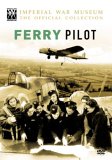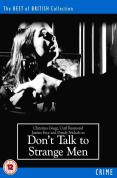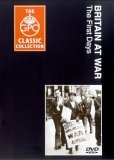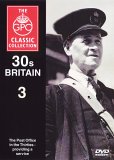 Imperial War Museum - Ferry Pilot | DVD | (21/03/2005)
from £6.71
| Saving you £3.28 (48.88%)
| RRP
Imperial War Museum - Ferry Pilot | DVD | (21/03/2005)
from £6.71
| Saving you £3.28 (48.88%)
| RRP Made in 1941 by the Crown Film Unit 'Ferry Pilot' focuses on the work of the Air Transport Auxiliary (ATA). By 1941 literally hundreds of RAF fighters and bombers needed to be flown each day between aircraft factories maintenance depots and RAF aerodromes. This vital task was carried out by the men and women of the ATA a civilian air force operating from their own pools and stations all over Britain. The film features coverage of the ATA's own fleet of Ansons as well as some
![The Prisoner - Vol. 2 - Episodes 5 To 8 [1967]](/pictures/1004370.jpg) The Prisoner - Vol. 2 - Episodes 5 To 8 | DVD | (14/08/2000)
from £N/A
| Saving you £N/A (N/A%)
| RRP
The Prisoner - Vol. 2 - Episodes 5 To 8 | DVD | (14/08/2000)
from £N/A
| Saving you £N/A (N/A%)
| RRP The most famous the most acclaimed and the most intriguing of all classic television thrillers starring Patrick McGoohan as a man with no name but with only a number.... Number Six. Trapped in an inescapable village Number Six is discovering that life is a battle with the ever-changing Number Two and that there may never be an end to the nightmare. Episode 5 - The Schizoid Man: Number Six awakes to find he has an identical twin. Episode 6 - The General: A subliminal teaching method is being used in The Village. Episode 7 - Many Happy Returns: The Village appears dead and Number Six escapes... or has he? Episode 8 - Dance of the Dead: It's carnival time in The Village... by order people will be happy.
 Don't Talk To Strange Men | DVD | (24/09/2007)
from £N/A
| Saving you £N/A (N/A%)
| RRP
Don't Talk To Strange Men | DVD | (24/09/2007)
from £N/A
| Saving you £N/A (N/A%)
| RRP A young girl accepts a lift home from a stranger. Moments later she lies dead; another victim of the murderer who is targeting young impressionable women. Whilst Christina (Jean Painter) is waiting for a bus on a deserted country lane she answers the ringing telephone in the public callbox. She begins to chat with the charming stranger and arranges for the man to call her at the callbox the next night. Fearful for her safety Christinas parents forbid her to go out alone at night whilst the murderer is still at large. But Christina continues her schoolgirl dalliances with her romantic stranger and arranges to meet him on a dark and lonely night at the callbox
![The Prisoner [1967]](/pictures/1004371.jpg) The Prisoner | DVD | (21/08/2000)
from £62.99
| Saving you £-3.00 (N/A%)
| RRP
The Prisoner | DVD | (21/08/2000)
from £62.99
| Saving you £-3.00 (N/A%)
| RRP Part action series, part psychedelic fantasy, part allegory, Patrick McGoohan's masterpiece, The Prisoner, was initially touted as a sequel to his earlier spy series, Danger Man. But when it was first broadcast in 1967 TV audiences were puzzled; when the show was cancelled 17 episodes later due to declining viewing figures, no one was any the wiser. Shot in the picturesque surroundings of Portmeirion in North Wales, whose architectural fantasies provided an ideal backdrop for the show's surrealism, The Prisoner has subsequently been recognised as one of the most innovative and thought-provoking series ever to be broadcast. Despite the primary-coloured flower-power look, the show's bold ideas haven't dated at all, proving that The Prisoner was simply years ahead of its time.McGoohan is Number 6, a man whose resignation from the secret service (seen every week in a montage title sequence--itself an impressionistic TV landmark) triggers his abduction and imprisonment in "The Village", a sort of open prison for spies where everyone has a number not a name. It's a pretty comfortable place and the other inhabitants all seem passively to accept the situation, allowing the Village authorities to control and limit their actions without protest (escape attempts are thwarted by mysterious bubble-shaped guards called "Rovers"). Number 6, however, is an indomitable freedom fighter whose refusal to accept the status quo is a metaphor for the individual ego struggling against the forces of social conformity: "I am not a number I am a free man" is the series' most resonant catchphrase. The Village's allegorical microcosm of society is presided over by Number 2, played by a different actor every week, with whom Number 6 clashes repeatedly in a battle of wills as he continually questions the authority that has imprisoned him ("Who is Number 1?"). In turn the Kafkaesque authorities try to discover the reason why he resigned. His trenchant refusal to provide any reason at all is itself a powerful assertion of individual freedom. The series culminates in perhaps the most bizarre and psychedelic TV episode ever made, "Fallout", in which Number 6's revelatory discovery of the real power that keeps him imprisoned raises more questions than it answers. --Mark Walker
![Man In A Suitcase - Complete [1967]](/pictures/1010946.jpg) Man In A Suitcase - Complete | DVD | (29/08/2005)
from £N/A
| Saving you £N/A (N/A%)
| RRP
Man In A Suitcase - Complete | DVD | (29/08/2005)
from £N/A
| Saving you £N/A (N/A%)
| RRP Richard Bradford is ex-CIA agent 'Mac' McGill who now works as a private investigator. He goes from job to job living out hotel rooms with all his worldly possessions in one old brown suitcase... Featuring all the episodes ever made! Episodes comprise: 1. Brainwash 2. The Sitting Pigeon 3. Day of Execution 4. Variation on a Million Bucks (1) 5. Variation on a Million Bucks (2) 6. Man from the Dead 7. Sweet Sue 8. Essay in Evil 9. The Girl Who Never Was 10. All That Glitter
![Man In A Suitcase - Vol. 1 - Episodes 1 And 2 - Man From The Dead / Brainwash [1967]](/pictures/1004413.jpg) Man In A Suitcase - Vol. 1 - Episodes 1 And 2 - Man From The Dead / Brainwash | DVD | (10/07/2000)
from £N/A
| Saving you £N/A (N/A%)
| RRP
Man In A Suitcase - Vol. 1 - Episodes 1 And 2 - Man From The Dead / Brainwash | DVD | (10/07/2000)
from £N/A
| Saving you £N/A (N/A%)
| RRP Taking the well-travelled outlaw hero format of The Saint and reinventing the hero as a Mickey Spillane-like Yank, this tough-edged but trivial detective series stars the brick-like Richard Bradford as McGill as a former CIA man who owns only a gun and a change of clothes (hence the title) and wanders about foreign locales, using two-fisted methods to protect beautiful women or foil dastardly plots. Ron Grainer's title theme is among the best 60s TV tunes, and the intense, serious Bradford makes a refreshing change after so many breezy, unflappable, eyebrow-cocking heroes, but the mix of postcard backdrops, character villains and drama-school totty is much the same as in The Saint, Danger Man, The Persuaders, and their ilk. Volume One includes: "Man from the Dead", in which McGill tracks his supposedly dead CIA ex-boss, with Angela Brown; and "Brainwash" in which McGill is after the traitor who framed him, with Suzan (Dracula, Prince of Darkness) Farmer. --Kim Newman
 Britain At War - The First Days | DVD | (14/11/2005)
from £21.58
| Saving you £-5.59 (-35.00%)
| RRP
Britain At War - The First Days | DVD | (14/11/2005)
from £21.58
| Saving you £-5.59 (-35.00%)
| RRP The First Days (1939): directed by Harry Watt Humphrey Jennings and Pat Jackson - Preparation for war on the home front. The Front Line (1939): directed by Harry Watt. Dover becomes a target for the Germans. Squadron 992 (1940): directed by Harry Watt. A barrage balloon squadron is trained and deployed to South Queensferry to defend Rosyth Naval Base and the Forth Bridge. Includes a reconstruction of the Luftwaffe raid of October 16 1939.
 30's Britain Volume 3 - GPO Classic Collection | DVD | (31/07/2006)
from £21.58
| Saving you £-5.59 (N/A%)
| RRP
30's Britain Volume 3 - GPO Classic Collection | DVD | (31/07/2006)
from £21.58
| Saving you £-5.59 (N/A%)
| RRP The King's Stamp (1935): directed by William Coldstream. The designing and printing of the King George V Silver Jubilee stamp followed by a short history of postage stamps. The Fairy Of The Phone (1936): directed by William Coldstream. A fanciful comedy on how to use the telephone. News For The Navy (1937): directed by Norman McLaren. Following a package from letter box to delivery to HMS Incredible in Bermuda. N or NW (1937): directed by Len Lye. The importance of correctly addressing a letter of apology. Roadways (1937): directed by Stuart Legg and William Coldstream. The history of transport especially the growth in road traffic. The Horsey Mail (1938): directed by Pat Jackson. The mail is delivered by boat when part of East Norfolk is hit by floods. Mony A Pickle (1939): produced by Alberto Cavalcanti. The Post Office Savings Bank is a natural target for Scottish thrift. Nine For Six (1939): A telegram saves the day when a football team loses its only ball just before a match.

Please wait. Loading...
This site uses cookies.
More details in our privacy policy